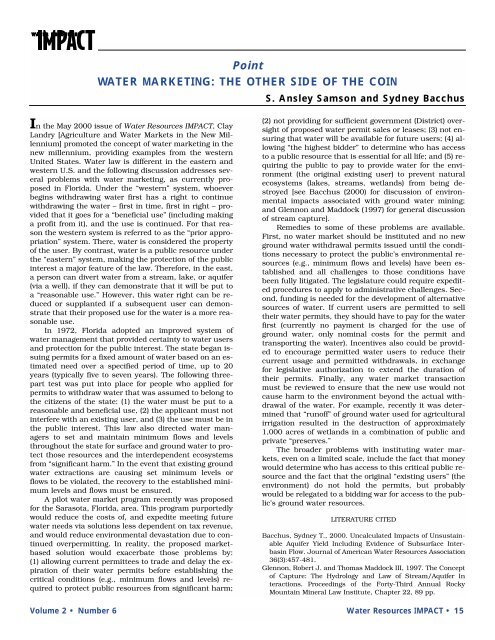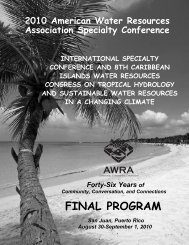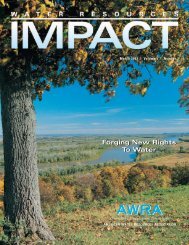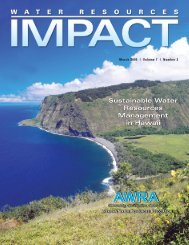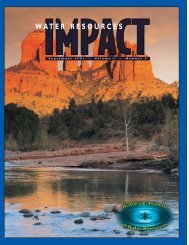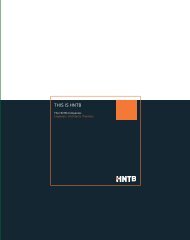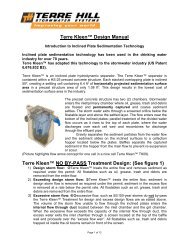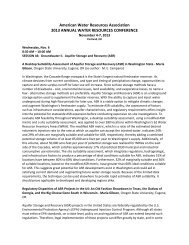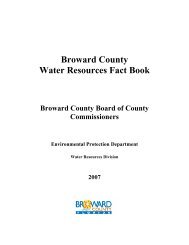N ovember 2 0 0 0 ⢠V olume 2 ⢠N umber 6 - American Water ...
N ovember 2 0 0 0 ⢠V olume 2 ⢠N umber 6 - American Water ...
N ovember 2 0 0 0 ⢠V olume 2 ⢠N umber 6 - American Water ...
Create successful ePaper yourself
Turn your PDF publications into a flip-book with our unique Google optimized e-Paper software.
Point<br />
WATER MARKETING: THE OTHER SIDE OF THE COIN<br />
S. Ansley Samson and Sydney Bacchus<br />
In the May 2000 issue of <strong>Water</strong> Resources IMPACT, Clay<br />
Landry [Agriculture and <strong>Water</strong> Markets in the New Millennium]<br />
promoted the concept of water marketing in the<br />
new millennium, providing examples from the western<br />
United States. <strong>Water</strong> law is different in the eastern and<br />
western U.S. and the following discussion addresses several<br />
problems with water marketing, as currently proposed<br />
in Florida. Under the “western” system, whoever<br />
begins withdrawing water first has a right to continue<br />
withdrawing the water – first in time, first in right – provided<br />
that it goes for a “beneficial use” (including making<br />
a profit from it), and the use is continued. For that reason<br />
the western system is referred to as the “prior appropriation”<br />
system. There, water is considered the property<br />
of the user. By contrast, water is a public resource under<br />
the “eastern” system, making the protection of the public<br />
interest a major feature of the law. Therefore, in the east,<br />
a person can divert water from a stream, lake, or aquifer<br />
(via a well), if they can demonstrate that it will be put to<br />
a “reasonable use.” However, this water right can be reduced<br />
or supplanted if a subsequent user can demonstrate<br />
that their proposed use for the water is a more reasonable<br />
use.<br />
In 1972, Florida adopted an improved system of<br />
water management that provided certainty to water users<br />
and protection for the public interest. The state began issuing<br />
permits for a fixed amount of water based on an estimated<br />
need over a specified period of time, up to 20<br />
years (typically five to seven years). The following threepart<br />
test was put into place for people who applied for<br />
permits to withdraw water that was assumed to belong to<br />
the citizens of the state: (1) the water must be put to a<br />
reasonable and beneficial use, (2) the applicant must not<br />
interfere with an existing user, and (3) the use must be in<br />
the public interest. This law also directed water managers<br />
to set and maintain minimum flows and levels<br />
throughout the state for surface and ground water to protect<br />
those resources and the interdependent ecosystems<br />
from “significant harm.” In the event that existing ground<br />
water extractions are causing set minimum levels or<br />
flows to be violated, the recovery to the established minimum<br />
levels and flows must be ensured.<br />
A pilot water market program recently was proposed<br />
for the Sarasota, Florida, area. This program purportedly<br />
would reduce the costs of, and expedite meeting future<br />
water needs via solutions less dependent on tax revenue,<br />
and would reduce environmental devastation due to continued<br />
overpermitting. In reality, the proposed marketbased<br />
solution would exacerbate those problems by:<br />
(1) allowing current permittees to trade and delay the expiration<br />
of their water permits before establishing the<br />
critical conditions (e.g., minimum flows and levels) required<br />
to protect public resources from significant harm;<br />
(2) not providing for sufficient government (District) oversight<br />
of proposed water permit sales or leases; (3) not ensuring<br />
that water will be available for future users; (4) allowing<br />
“the highest bidder” to determine who has access<br />
to a public resource that is essential for all life; and (5) requiring<br />
the public to pay to provide water for the environment<br />
(the original existing user) to prevent natural<br />
ecosystems (lakes, streams, wetlands) from being destroyed<br />
[see Bacchus (2000) for discussion of environmental<br />
impacts associated with ground water mining;<br />
and Glennon and Maddock (1997) for general discussion<br />
of stream capture].<br />
Remedies to some of these problems are available.<br />
First, no water market should be instituted and no new<br />
ground water withdrawal permits issued until the conditions<br />
necessary to protect the public’s environmental resources<br />
(e.g., minimum flows and levels) have been established<br />
and all challenges to those conditions have<br />
been fully litigated. The legislature could require expedited<br />
procedures to apply to administrative challenges. Second,<br />
funding is needed for the development of alternative<br />
sources of water. If current users are permitted to sell<br />
their water permits, they should have to pay for the water<br />
first (currently no payment is charged for the use of<br />
ground water, only nominal costs for the permit and<br />
transporting the water). Incentives also could be provided<br />
to encourage permitted water users to reduce their<br />
current usage and permitted withdrawals, in exchange<br />
for legislative authorization to extend the duration of<br />
their permits. Finally, any water market transaction<br />
must be reviewed to ensure that the new use would not<br />
cause harm to the environment beyond the actual withdrawal<br />
of the water. For example, recently it was determined<br />
that “runoff” of ground water used for agricultural<br />
irrigation resulted in the destruction of approximately<br />
1,000 acres of wetlands in a combination of public and<br />
private “preserves.”<br />
The broader problems with instituting water markets,<br />
even on a limited scale, include the fact that money<br />
would determine who has access to this critical public resource<br />
and the fact that the original “existing users” (the<br />
environment) do not hold the permits, but probably<br />
would be relegated to a bidding war for access to the public’s<br />
ground water resources.<br />
LITERATURE CITED<br />
Bacchus, Sydney T., 2000. Uncalculated Impacts of Unsustainable<br />
Aquifer Yield Including Evidence of Subsurface Interbasin<br />
Flow. Journal of <strong>American</strong> <strong>Water</strong> Resources Association<br />
36(3):457-481.<br />
Glennon, Robert J. and Thomas Maddock III, 1997. The Concept<br />
of Capture: The Hydrology and Law of Stream/Aquifer In<br />
teractions. Proceedings of the Forty-Third Annual Rocky<br />
Mountain Mineral Law Institute, Chapter 22, 89 pp.<br />
V<strong>olume</strong> 2 • N<strong>umber</strong> 6 <strong>Water</strong> Resources IMPACT • 15


